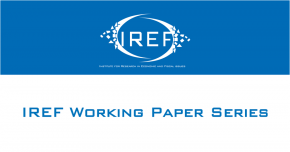According to a recent representative survey conducted by Der Spiegel, a majority in Germany does not consider the country’s income distribution to be fair. 47.3 percent of the respondents consider the income distribution to be „definitely not fair“ and for 27.5 percent it is „rather not fair“. Only 4.4 percent perceive it as „definitely fair“ and 12.5 percent as „rather fair“. However, is the observed income inequality really unfair? And, what degree of inequality would be fair? An IREF Working Paper by Pablo Duarte tackles these questions empirically.
Observable distributions vs. underlying processes
What is fair or just? A seemingly easy question that is hard to answer. In his paper, Duarte discusses two concepts of justice: distributive justice and procedural justice. Distributive justice uses criteria of justice by focusing on the observable distribution of income or wealth that results from a social process. For instance, complete income equality would be just from a strict material egalitarian perspective.
In contrast, procedural justice does not focus on the result – the income distribution. Procedural justice considers the social process that gives rise to a certain distribution of income. If the process, and thus the „rules of the game“ from which the income distribution results, is just, the income distribution is just, too. Pointing to the tradition of Rawls‘ A Theory of Justice and Brennan und Buchanan‘s „The Reason of Rules“ Duarte argues that equality before the law is key as it is a necessary condition for procedural justice.
So far, empirical analyses use the observable income inequality to assess the fairness of the distribution of income. In contrast, Duarte employs data on the equality before the law to use as measuring rod for fairness the process from which the distribution results.
Equality before the law: effects
Duarte includes 87 countries worldwide and uses data on income inequality provided by the Standardized World Income Inequality Database (SWIID). To measure the degree of equality before the law quantitatively he relies on data provided by the World Justice Project, namely two components of their Rule of Law index. These do not capture the de jure equality before the law, but rather assess the de facto equality before the law based on surveys.
Without controlling for further factors that may affect the income distribution, Duarte does not find any relationship between the degree of income inequality and equality before the law. The picture changes when he accounts for the regions countries belong to, the countries‘ GDP in per capita terms, and the interaction of GDP in per capita terms and equality before the law. The results point to a non-linear effect of the equality of law.
The higher a country’s GDP, the more an increase in equality before the law reduces the inequality of market incomes. In countries with relatively low levels of GDP the interaction between GDP and equality before the law may result, however, in increases in equality before the law leading to more unequal market incomes. Duarte finds such an inequality-increasing effect of a rise in equality before the law for the six poorest countries in the sample, all of which are to be found in sub-Saharan Africa. He attributes this to the broadening of feasible productive activities through an increase in equality before the law that allows for higher incomes for disadvantaged individuals.
Based on the results Duarte calculates a hypothetical income distribution for each country that would prevail if procedural justice was complete. He finds that today’s income inequality in most countries is higher than the degree of inequality that could be expected if complete procedural justice prevailed.
Duarte also investigates if inequality before the law leads to more redistribution by the government. The income inequality, which results from inequality before the law and is possibly considered to be unjust, can be reduced by redistribution. To measure the degree of redistribution Duarte compares the Gini-coefficient – a common measure of inequality – of the income distribution before and after redistribution by the government. At first sight the results are in line with the intuition that more equality before the law goes hand in hand with less redistribution. But here, too, GDP and equality before the law interact. The effect is less pronounced in richer countries and may even reverse so that an increase in equality before the law is accompanied by more redistribution.
Enforcement of the rules of the game
The enforcement of generally accepted rules of the game can contribute to a reduction in income inequality and add to the perceived fairness of the resulting income distribution. According to the results of the present paper this applies the more so the higher a country’s GDP per capita is. This in turn suggests that a higher degree of procedural justice through more equality before the law could reduce the level of dissatisfaction with the income distribution in industrialized countries such as Germany.



